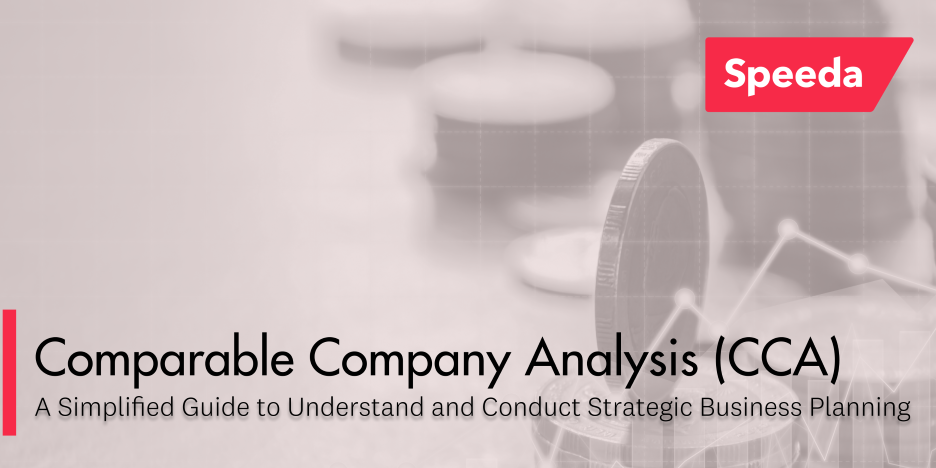Resource Center
Guide: Comparable Company Analysis (CCA)

A Simplified Guide to Understand and Conduct Strategic Business Planning
When it comes to analysing a business, several methodologies stand at the ready for businesses, analysts and investors alike. Among these, Comparable Company Analysis (CCA) stands out as a pivotal tool employed to gauge the financial standing and market value of a company by drawing parallels with its industry peers. This valuation technique rests on the premise that companies sharing similar attributes—in terms of size, industry, and market presence—are likely to have comparable valuations.
What is Comparable Company Analysis (CCA)?
Comparable Company Analysis is a valuation technique that compares the financial ratios and metrics of similar public companies to assess the value of another business. This method is considered relative as it evaluates entities based on existing market valuations, unlike intrinsic methods like Discounted Cash Flow (DCF) analysis, which forecasts future cash flows.
The Rationale Behind CCA
- Market Benchmarking: CCA allows one to position a company within the broader market landscape by comparing it against firms with similar operations and financial structures. This comparison helps in understanding where a company stands by relevant metrics compared to its peers.
- Investment Decision-Making: By assessing the financial health and market valuation of comparable companies, one can better identify potential investment opportunities and risks.
- Mergers and Acquisitions: In the M&A process, CCA is crucial for determining the offer price for a target company. By analysing how similar companies are valued, acquirers can propose a fair price that reflects the target’s market standing and future potential.
- Fairness Opinions: CCA provides a quantitative basis for fairness opinions, which are independent assessments conducted to ascertain the fairness of the terms in a transaction from a financial point of view. This analysis supports the decision-making process for stakeholders involved in mergers, acquisitions, and other corporate restructuring activities.
- Strategic Planning: Companies use CCA to strategise their next moves in the market. Understanding how similar companies are valued and positioned and how they perform can influence strategic decisions such as entering new markets, diversifying product lines, or even altering business models to better compete in the industry.
- Financial Reporting and Compliance: For financial reporting purposes, companies may need to assess the fair value of certain assets and liabilities, especially when handling acquisitions and disposals. CCA provides a market-based context to these evaluations, helping ensure compliance with accounting standards.
Comparable Company Analysis vs. Precedent Transaction Analysis
Comparable Company Analysis (CCA) and Precedent Transaction Analysis (PTA) are both essential relative valuation methodologies used to determine a company’s worth by comparing it with similar entities. While both employ valuation multiples like EV/Revenue and EV/EBITDA, they differ significantly in their application and implications. CCA focuses on current market multiples without a takeover premium, reflecting ongoing trading values in public markets. In contrast, PTA includes a takeover premium and relies on historical M&A data, which may not always capture the latest market conditions but is crucial for understanding premiums paid in acquisitions.
The choice between CCA and PTA depends on the valuation’s purpose and data availability. CCA is suitable for regular valuation needs such as investment analysis, benefiting from its reliance on readily available current market data. PTA, however, is invaluable for merger and acquisition planning, offering insights into the extra financial incentives acquirers might pay for control.
How to Conduct Comparable Company Analysis (CCA)
Ⅰ. Identifying Comparable Companies
The initial step involves selecting the right peer group. Analysts begin by sourcing detailed descriptions and industry classifications from financial or business databases. The selection criteria often include industry, geography, size, growth rate, and financial metrics, ensuring a close match between the companies compared.
Peer Group Selection Criteria:
- Business Characteristics: This includes factors like the product or service mix and customer type, which should align closely with those of the target company to ensure relevancy in comparison.
- Financials: Key financial metrics such as revenue growth and operating margins are critical for ensuring that the companies within the peer group operate under similar economic conditions and performance benchmarks.
- Risks: Consideration of external factors such as regulatory changes, industry-specific challenges, and the competitive landscape is vital to understand the broader context in which these companies operate.
For instance, if compiling a peer group for a company like Amazon (NASDAQ: AMZN), which is predominantly known for its e-commerce platform but also has substantial operations in cloud computing and digital streaming, it’s crucial to select companies that mirror these diverse operations. Potential peers might include other e-commerce giants, tech companies with cloud services, and digital media providers.
Considering Amazon’s diverse business model, a suitable peer group might consist of companies like Alibaba, known for its e-commerce and cloud computing services, and Netflix, which competes in the digital streaming space. This approach ensures that the peer group reflects Amazon’s multifaceted operations, providing a more accurate and holistic valuation.
By dedicating significant effort to the selection process and acknowledging the uniqueness of each target company, one can enhance the precision of their analysis outcomes. While finding ‘pure-play’ comparables may be challenging, especially in industries where the target operates in a niche, maintaining a level of flexibility and realism in the selection process is crucial.
Ⅱ. Gathering Financial Data
Once peers are identified, gathering relevant financial data is next. Data platforms like Bloomberg Terminal, Capital IQ, or Speeda are instrumental here, enabling ones to import data directly into Excel. Depending on the lifecycle stage of the business, different metrics such as EBITDA, EPS, or gross profit might be analysed.
Ⅲ. Setting up the Comps Table
The information is then organised in a comps table in Excel, listing company names, market cap, net debt, revenue, and other pertinent financials. This setup facilitates a clear comparative analysis across different entities.
Ⅳ. Calculating Ratios
With the financial data in place, analysts calculate various valuation multiples like EV/Revenue, P/E, or P/BV. These ratios help in understanding how the market values the peer companies relative to their financial performance.
Ⅴ. Valuation
Finally, the average or median multiples from the comparable companies are applied to the subject company’s financials to estimate its value. This process might involve adjusting the figures to exclude outliers to ensure the valuation reflects a realistic market perception.
Pros and Cons of CCA
Comparable Company Analysis (CCA) is an established method in financial valuation, used extensively within sectors such as accounting, M&A, investment banking, and corporate finance. This approach, which compares the financial metrics of similar companies to estimate a company’s valuation, has distinct advantages and limitations. Understanding these can significantly enhance the efficacy and applicability of CCA in financial analysis.
Advantages of CCA
- Widely Adopted: CCA is a fundamental tool in financial analysis, providing a common framework for valuing companies across various industries. This widespread acceptance ensures a consistent approach in evaluating investment opportunities or company valuations.
- Accessibility: By utilising publicly available financial data such as SEC filings and market data, CCA makes it easier for analysts to collect the necessary information, thereby democratizing the valuation process.
- Simplicity and Clarity: The method involves straightforward comparisons of financial metrics which makes it accessible not only to financial experts but also to stakeholders with non-financial backgrounds.
- Flexibility: CCA can be applied across different industries, offering a versatile tool for analysts. Whether valuing tech start-ups or established manufacturing firms, CCA provides relevant insights.
- Complementary Tool: Often used in conjunction with other valuation methodologies like DCF or PTA, CCA helps provide a comprehensive view of a company’s worth.
Limitations of CCA
- Finding Comparables: One of the significant challenges with CCA is the difficulty in identifying truly comparable companies, especially for unique or niche entities. This can skew the valuation or render it less reliable.
- Market Volatility: The reliance on current market conditions means that CCA can be susceptible to short-term market fluctuations, which may not necessarily reflect the long-term value of a company.
- Overlooking Future Prospects: CCA primarily focuses on historical data and might not accurately capture future growth prospects or industry shifts, which are critical in today’s rapidly changing markets.
- Public Data Constraints: Since CCA depends heavily on publicly disclosed information, it may overlook crucial private data like undisclosed strategies or upcoming products that could affect a company’s valuation.
- Market Perception Bias: The method assumes market efficiency and often reflects the prevailing market sentiment, which may not always align with the intrinsic value of the company, potentially leading to mispricing.
How Speeda Can Mitigate the Limitations of CCA
To address some of the inherent limitations of CCA, one can leverage platforms like Speeda. Speeda provides extensive data coverage, including detailed financials of over 10 million public and private companies across diverse regions and industries. This vast database aids analysts in identifying a more accurate set of comparables, even in niche markets.
- Comprehensive Data Access: Speeda’s integration of public and private company data, along with industry research and M&A deals, ensures users to have a broader spectrum of information, reducing the reliance on publicly available data alone.
- Advanced Search Filters: The platform’s sophisticated search capabilities allow analysts to fine-tune their criteria for selecting comparable companies, thus enhancing the precision of CCA.
- Up-to-Date Market Insights: By continuously updating its database with the latest financial data and market trends, Speeda helps users consider the most current information, mitigating the impact of market volatility.
- Expert Insights: Speeda’s expert network service provides additional qualitative analysis that can complement the quantitative data used in CCA, offering a more rounded view of a company’s valuation.



























